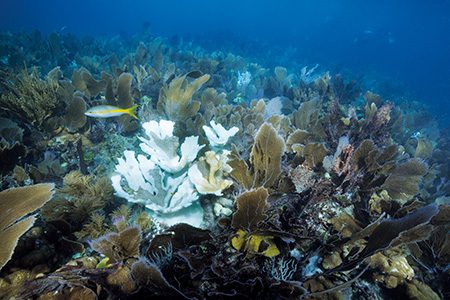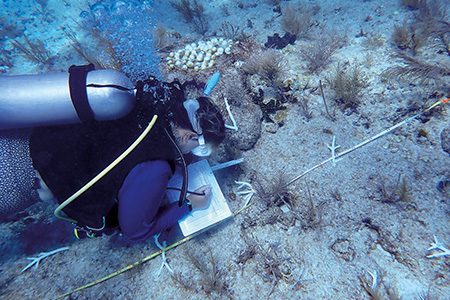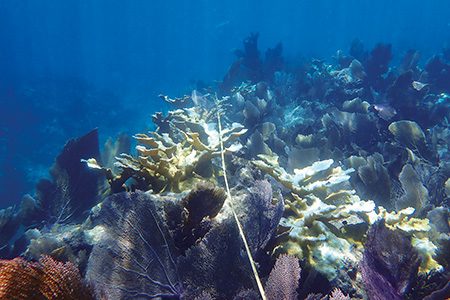This past summer the Florida Keys experienced the effects of a marine heatwave event that lasted longer and was more intense than anything in recent recorded history. By early June 2023 the National Oceanic and Atmospheric Administration (NOAA) Coral Reef Watch (CRW) issued bleaching warnings for some areas in the Florida Keys and other locations in the Caribbean. By late July many reefs had exhibited widespread bleaching as the highest bleaching alert level at the time — level 2 — was issued.
Instruments on reef bottoms in the Middle and Lower Keys recorded temperatures exceeding 93°F (34°C) for several days, well above the 87°F (30.5°C) threshold at which many corals in this region become susceptible to bleaching. The marine heatwave’s intensity and duration led CRW to create three new and more alarming bleaching alert levels.
The event extended into October, and it is now clear that severe bleaching caused high levels of mortality. The conditions left corals too long without single-celled algae,their key symbiotic partners, which produce food, process wastes, and give corals their vibrant color.
The event affected both wild coral colonies and restored (or outplanted) colonies. The outplanted corals, placed on reefs from Key Largo to Key West, represented more than two decades of efforts pioneered in the Florida Keys to restore reef ecosystem diversity and function. Considering the losses from this past summer and the predicted continued impacts of climate change, reef restoration efforts must enter a new phase of planning and implementation with a rigorous and adaptable climate-ready approach.
A climate-informed framework for coral restoration is already underway in the Florida Keys National Marine Sanctuary (FKNMS). Mission: Iconic Reefs (M:IR) is a multidecade NOAA-led and partner-driven effort to restore coral diversity and ecosystem function on seven ecologically and culturally significant reefs.

M:IR was designed with a strong foundation of adaptive management, defined by the Reef Resilience Network as being “systems-based, proactive, flexible, iterative, and responsive.” Through frequent monitoring and evaluation of program status, goals, and outplant performance, M:IR managers, scientists, and reef restoration partner practitioners can adjust plans over time, especially as our understanding grows while climate change continues.
This holistic approach to stewardship and restoration aims to increase coral cover at these seven target reefs from an average of 2% to 25% over several decades. This admittedly ambitious effort will entail preparing outplant sites for successful coral attachment, long-term maintenance of outplants, coral predator management, and the reintroduction of two key invertebrate herbivores that consume macroalgae: the long-spined sea urchin and the Caribbean king crab. Data from studies conducted in the months following the bleaching event will provide valuable insight into how best to adjust the course for M:IR restoration plans.
I was among a team of researchers that surveyed five reefs in mid-February 2024 to collect information on surviving elkhorn and staghorn outplants, two fast-growing but threatened species used widely in reef restoration efforts in this region. By combining our results with restoration practitioners’ data, we can assess characteristics that may have helped these colonies survive and leverage that knowledge to enhance the success of future outplanting efforts. Survival may correlate with reef habitat, outplant age and size, and genetics of individual corals.
Conditions along different reef habitats — including light levels, water flow, and temperature — influence the growth, health, and mortality of species such as elkhorn and staghorn corals. By comparing the depth and spatial distribution of outplants with detailed maps of habitat zones, along with the physical conditions recorded at sites throughout the event, we can determine if there are habitat zones within and across reefs that have higher numbers of survivors.
We may see, for example, that very shallow areas where elkhorn coral historically existed may not harbor live corals anymore, given the high light levels and elevated temperatures during hot, windless summer days. With this information, restoration practitioners can shift to outplanting elkhorn corals in more suitable areas informed by survivor location, thereby increasing the chance of success for these efforts.
Anecdotal evidence implies that older (and often larger) outplants may have higher survival rates than younger and smaller ones. Impacts from corallivores, sedimentation, and macroalgae all have disproportionate effects on smaller colonies. Smaller colonies, however, may be able to more efficiently transfer metabolic products, including waste, helping maintain health when corals are in a stressed state.


A preliminary analysis of the data from survivors indicates that corals outplanted just before the heating event had high mortality rates earlier in the summer, likely because they did not have sufficient time to acclimate to their new environment before bleaching. Corals may experience stress after being relocated to a new environment, which can leave them vulnerable and more susceptible to bleaching, especially if conditions in the new environment are not stable for an extended period.
By examining all these metrics for each surviving colony — age and size, the impacts mentioned above, and timing of recent outplanting — we can understand what criteria we can more intently examine for making informed decisions about how to resume outplanting at each site.
A coral’s genetics (or its genotype) and the genetic makeup of its single-celled algal symbionts can heavily influence all these outcomes. Restoration practitioners may work with hundreds of known genotypes of a given coral species, which is critical for maintaining and increasing genetic diversity on restored reefs. Experimental studies examining the performance of a given species under stressful scenarios, such as high temperature or low pH, have demonstrated links between genotype and outcome. Such investigations have allowed us to identify genotypes with desirable traits, including high-temperature tolerance, which can be propagated and strategically integrated into restoration design.
Corals can host different species of their algal symbionts, which also range in characteristics, including level of heat tolerance. Experiments inducing corals to swap symbiont types have shown that they can retain these partners for months or even years. Because restoration practitioners note which genotypes are outplanted in each location, we can examine the suite of genotypes that survived and determine if there are patterns within and between reef sites.
Finally, there is some evidence that sexually produced coral outplants from land-based facilities (each possessing a unique genotype that may not be formally characterized) had higher survival rates than those grown as fragments of other colonies, but further investigation is required to determine why. It is important to note that finding desirable traits may come with tradeoffs. A coral with high heat tolerance may be more susceptible to disease, for example, so maintaining a high level of genetic diversity on reefs is the best practice for supporting resilience and adaptation to a wide range of conditions.
Other species collectively labeled by morphology as boulder, brain, and massive corals fared better in the bleaching event. Not all individuals of these wild and outplanted corals were fully bleached even at the height of the summer heat, and many of those that did bleach showed signs of recovery by late fall. While some increases in disease were noted on these corals as temperatures subsided, many have recovered and continue to grow.
Before last year’s bleaching event, M:IR planned to focus on outplanting the boulder, brain, and massive corals in large quantities following several years of staghorn and elkhorn coral replenishment, allowing restoration practitioners more time to cultivate these slower-growing species. We are now working with partners to develop novel technologies to advance and scale up propagation and outplanting techniques for these species of corals. The combination of the hope provided by these survivors and their presumed resistance and resilience to temperature-induced bleaching has spurred managers and partners to shift toward implementing this phase of the project in the immediate future.


What have we learned, and how are we responding?
• The health of corals and reefs will continue to be influenced by local factors that need to be better characterized and managed and by changing climate conditions that are out of our immediate control.
• M:IR is collaborating with researchers to start tracking water-quality metrics, including heavy metal contaminants, environmental toxins, nutrient loads, and sedimentation.
• Expansion of data stations is underway to provide direct insight into localized effects of ocean acidification, hot spots, and sites that may be buffered from these climate stressors and can provide refuge for corals.
• Recognizing the linkages between our reefs and Florida Bay, FKNMS and partners are working closely to develop better early warning systems, data buoy networks, and long-term monitoring programs and to introduce novel technologies to mitigate stressors associated with Florida Bay water.
• While remedying locally driven impacts on water and sediment quality and other nonclimate stressors will take time, understanding the current conditions within reef sites can assist practitioners in selecting the most suitable locations for outplanting corals.
• This past summer reminded us that coral restoration is not the ultimate solution, but it will be critical for maintaining some level of reef ecosystem diversity and function while we collectively grapple with climate change policy and remediation.
Restoration practitioners will continue to work with FKNMS to identify and implement new restoration approaches, appropriate monitoring methods, and midcourse corrections as needed. This effort will be accomplished through active, hands-on pilot experiments, consultations with experts, and more effective and streamlined permitting processes.
It is important to note that the outplanted corals that did not survive this past summer still provided ecosystem services during the time that they were alive — whether for one year or 10 years — and new corals that are outplanted with the resumption of climate-ready and scientifically informed restoration efforts will continue to do the same.
© Penyelam Siaga — Q2 2024